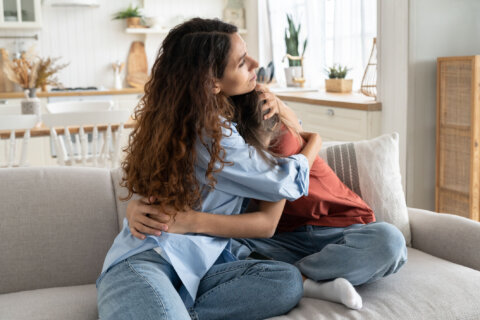Fear can be a helpful emotion, particularly for children who are learning to navigate the world. Feeling afraid lets them know when they are in danger and helps them respond.
On the other hand, many children today struggle with anxiety that goes beyond what’s considered normal and healthy. The key is identifying when your child’s fear has changed from productive to harmful. The first step is to understand the different types of anxiety. These include:
— Generalized anxiety.
— Situational anxiety and phobias.
Generalized Anxiety
Generalized anxiety makes your child feel uneasy and nervous about the future. It can refer to worries about everyday issues, such as schoolwork, managing relationships and performing well in extracurricular activities.
Your child needs some anxiety to be motivated to get things done. This is called healthy or productive anxiety. For example, healthy anxiety is what prompts your child to stop watching YouTube videos and start preparing for an upcoming test.
But sometimes anxiety persists, even when it’s no longer helpful. It can get in the way of your child’s life and ability to function.
Situational Anxiety and Phobias
Some kids only struggle with anxiety in very specific circumstances. This is called situational anxiety. For example, your child may have anxiety only in dark rooms at night.
If your child keeps avoiding a situation due to fear of experiencing situational anxiety — or endures the situation and suffers intense distress — he or she may have developed a phobia. Although a child may think of the situation itself as dangerous, what the child is really afraid of are the feelings of fear and panic that he or she associates with that situation.
Phobias can make your child’s life difficult due to the extreme effort the child puts into avoiding triggering situations. The more places where your child has feelings of anxiety, the more situations the child avoids. Kids can get stuck in a cycle of fear and anxiety that reinforces phobias. By feeling a short-term sense of relief when they avoid the situation, they “train” their bodies that avoidance is the best strategy. The world becomes smaller and scarier.
[Read: Sneaky Signs of Childhood Anxiety.]
Social Anxiety
Many people think phobias are only about fearing things like spiders (arachnophobia) or small spaces ( claustrophobia). But for many children, it’s common to struggle with social phobia, also known as social anxiety.
Social anxiety involves experiencing anxiety, fear or panic in situations where other people are watching or paying attention. Kids with social anxiety dread having other people even notice if their voice is shaky or their hands are trembling. They are terrified of making a mistake or appearing weak in front of others. Studies have shown that some personality traits, such as shyness, introversion and perfectionism, put a child at higher risk for developing social anxiety.
Kids with social anxiety struggle with two main categories of situations: performance situations and interactive situations; and they often go together. Some children fear both types of situations. Children who fear performance situations find it difficult to do any kind of public speaking, even answering questions in class or giving a presentation. They may fear participating in a competition or sporting event. Those who fear interactive situations may experience heightened anxiety at social gatherings, such as birthday parties, meetings, lunch and recess. They may dread talking through a conflict with a peer, initiating conversations or even going out with a group of friends.
What Your Child May Be Experiencing
The way to help children manage excess fear and unhealthy anxiety is to teach them to understand what’s happening when they are caught in a cycle of fear and anxiety, and provide them with skills to cognitively reframe triggering situations as they work to calm down their bodies.
The cycle of fear and anxiety has three components:
— Physical feelings.
— Automatic thinking.
— Behaviors.
The cycle can begin with any one of the three components and expand to the other two. For example, a child may first notice a racing heartbeat, and then start to think, “I can’t do this; I’m too scared.” Or, a child may be thinking, “I have to be perfect; I can’t mess up,” and then suddenly a bout of shaking and trembling begins. Or perhaps the child was unable to do something, like wear a usual “lucky shirt” on the day of a test, and this simple change in what the child does (or doesn’t do) — the behavior — leads to feelings of dread and thoughts of doom.
There are many common physical symptoms your child may experience in scary situations. They might have weak legs, shaky hands or a trembling voice. It may be hard to swallow or catch a satisfying breath. Some kids feel dizzy and numb, almost as if they were floating above their own body. Other physical symptoms include rapid heartbeat, chest discomfort, dry mouth, stomach pain or a choking sensation.
Too much anxiety can even lead to a panic attack, when the child experiences an intense rush of fear — even though there isn’t an actual life-threatening danger — along with multiple physical symptoms.
A child prone to anxiety has a brain that automatically fills with negative thoughts that reflect black and white thinking — or very rigid, inflexible ways of looking at the world. These negative thoughts distort reality and make your child feel far more anxious. It takes some practice to identify these negative thoughts. They often assume catastrophic outcomes — or that the worst will happen: “I will mess up and cry in front of everyone and lose all my friends.” These thoughts feed into the cycle of fear and anxiety.
[Read: 6 Things to Know About Childhood Depression.]
What You Can Do
First, take a moment to recognize that you’re not alone in parenting a child with anxiety. It can feel overwhelming when your child screams, refuses to go to school or is unable to transition through their daily activities. The hopeful news is that anxiety is one of the most treatable psychological conditions. The first step is to get a referral to a psychologist or social worker who specializes in childhood anxiety. Your pediatrician or family doctor can help you with this.
In addition to seeking help from a therapist or social worker for the anxious child, parents can benefit from joining support groups or speaking with a licensed psychologist to work through their own mounting anxiety and frustration about the child’s situation.
Through practice in therapy and at home, one of the most important techniques your child can learn to master anxiety involves replacing automatic negative thoughts with positive coping thoughts. Some people refer to this dialogue as positive self-talk.
For example, if your child reports thinking, “I’m going to embarrass myself in front of everyone,” help the child identify this negative thought and replace it with, “These are just thoughts, not reality. Just because I fear something doesn’t make it true. Even when I make a mistake, people still care about me.”
The coping thoughts should be realistic and meaningful; if your child doesn’t believe them, the coping thoughts won’t be effective. Try to think of the most accurate outcome or explanation for the situation, not necessarily the most positive. For a child who struggles socially at recess, this self-talk might be, “Even if I’m not invited to be part of a game with the popular kids, I can find something to do, and I will get through recess. I’ve been successful at talking with a couple new friends, so maybe I’ll look for them today.”
Two excellent forms of therapy that can help your child change unhealthy thought patterns are cognitive behavioral therapy, and acceptance and commitment therapy. You can discuss these options with your child’s therapist and learn how to support your child at home. Relaxation training, such as abdominal breathing, meditation and progressive muscle relaxation, can also help ease your child’s physical symptoms of anxiety.
[Read: What to Do If Your School-Age Child Struggles With Separation Anxiety.]
In addition, there are a variety of medicines that have proven effective in helping to manage the symptoms of pediatric anxiety disorders, especially when used in combination with talk therapy.
If you are concerned that your child is overly anxious, remember that there is help available, and it will eventually get better. Your child (and you) can get through this with support.
More from U.S. News
9 Phobias That Are Surprisingly Common
7 Ways to Build Resilience for Crises and Everyday Life Challenges
12 Questions You Should Ask Your Kids at Dinner
How to Help Kids With Anxiety originally appeared on usnews.com






